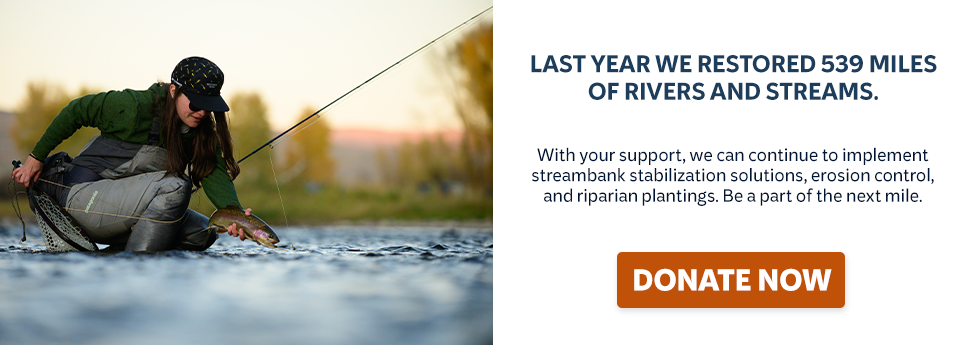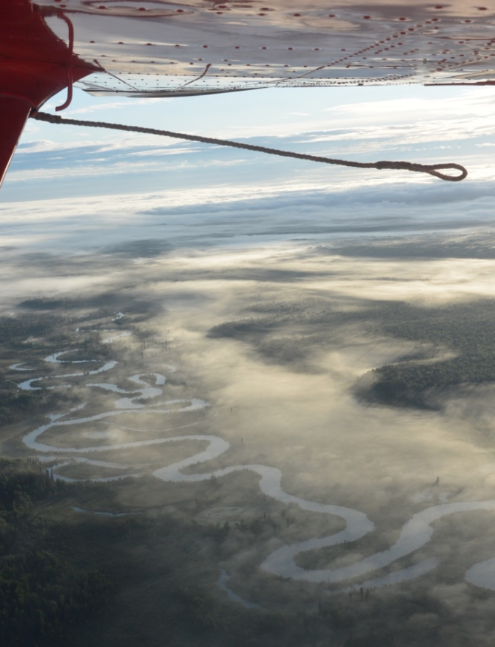Editor’s note: The following is the first of a two-part series.
By Eric Booton
The Trout Unlimited Alaska office is appropriately located on the shore of Anchorage’s Lake Hood, a hub for float plane traffic and a persistent reminder of the wild lands accessible in mere minutes, if you have the right transport for the job. The ex
hilarating screams of Cessnas and De Havilland Beavers ramping up to full throttle for takeoff is welcomed noise pollution, piercing the monotony of e-mail traffic and inflicting a momentary pause to conference calls. Nearly all adventurous Alaska fishing flicks have several things in common: wild
and native fish, bountiful wildlife featuring large mammals, rain, and of course, float planes, the trusted vessel for accessing Alaska’s 3 million lakes, rivers and streams. Of the dozens of planes that I watch tear down the lake on takeoff outside my office window I know that some of them are bound for a remote fishing destination and I can’t help but wish I was in a jumpseat headed out to fish with them.
—
The alarm goes off at 5:45 but I’m already up. I’ve been counting down the days for this adventure, hyping up my expectations and curtailing them with the reality that the only knowledge we have of our destination is limited to google maps and trip reports approaching several weeks old. I make my way to the kitchen and press “brew” on the coffee maker. Sam, a close friend since college and trusted adventure partner, is already up and adding the final additions to our gear pile. Still relatively new to the fly rod but achieving proficiency at a near alarming rate, Sam is here for two weeks of fishing with intentions of living out his recently found Alaska fishing dreams. I am pleased to help facilitate.
The water is glass when we arrive at Lake Hood. We waste no time hauling our gear to the float plane dock and patiently wait for our turn to take off while watching an overly domesticated ermine make its rounds through the benches and trash cans, providing a show for the camera wielding tourists. With the plane loaded, the deckhands remove the tie down ropes, provide a push from the dock and set us free while the pilot fires up the engine.
Approaching the end of the lake, the pilot makes a slow turn, and pulls the throttle as the prop of the plane points at the Trout Unlimited Alaska office. The engine rattling my body is muted by the pounding excitement in my chest as my grin spreads ear to ear. The floats leave the surface of the water, the pilot banks north as we fly over the office where my co-workers will soon be filing in. Sam and I bump fists—we are bound for 36 hours in search of salmon and trout on a remote tributary of Alaska’s mighty Susitna River.
The scenic flight was graced with low and dramatic clouds lingering just above the spruce trees, and looking like smoke coming off the bogs and wetlands. On our approach, circling a lake for landing, we scout the pools and runs of the river below while solidifying our bearings.
Maybe it was the slight shame of beefing it straight to my wader padded butt on the erosion wall greased with mud and wet leaves leading to the river, but my first impressions of the area didn’t fully mesh with my idyllic vision of our arrival. A lone angler was swinging for salmon only feet from where we set up our bear fence and established camp.
The commercial guide operations recently ended for the season and our new Danish friend reported that angler traffic for the past several days had been limited to their group (score!) and noted that they had only managed to catch a few chum salmon and trout while targeting coho salmon. Sitting on a large log on the river bank, buffed smooth by the elements, we lace up our trout rods, and fixed salmon rods to our backpacks. The water was high with signs of dropping, the weather was exceptional, and we had zero obligations other than avoiding bodily injury and combating “hanger” (the crippling morale breaker when one’s individual hunger drives them to expressive, but not necessarily recognized, anger).
It was time to find out for ourselves how the fishing was.
Remote areas of Alaska, away from road systems, suburbs and general conveniences, is routinely categorized as “the bush.” Referring to an area as “the bush” naturally conjures some consistent images—bushwhacking being not just one of those consistent images, but a reality. There is never a convenient route through a thicket of streamside willows. They do not grow uniformly and crisscross every inch of moveable room. Mix in a 9-foot fly rod and things get not just interesting, but just plain slow.
Only a couple hundred feet upstream from camp as the lucky crow flies, but nearly 10 minutes as the angler walks, we spy a slice of holding water downstream of a root wad and cannot refrain from making a couple drifts. Back casting room is non-existent, but a conscious roll cast does the trick and in just a few drifts, Sam and I have each caught and released at least one trout each and are throwing high fives. It’s evident that this trip will be a success.
on” />
It’s not long after our brief trout break that we reach the rest of the crew from Denmark, congregated downstream of the inflow of a brief side channel, swinging in near unison and thankfully fishing a minimal amount of water. With little prodding we get the details we are after — chum salmon, some trout and nothing but fresh water upstream. The exploration continues, threading the non-stop willow needle, maximizing our flexibility and waders’ inseams whilst stepping over downed trees.
Finding ourselves atop a riverside cliff, we paused to survey the river below, noting the salmon holding water, likely trout lies, and agree that crossing the river, as rewarding as it may be, would be foolish to attempt with the high water. From our aerial view we eye a slow water pool with dozens of salmon holding, and as luck would have it, discover a conveniently placed rope to aide our descent. We thank the foresighted anglers wo came before us, and administer a weight test before rappelling our way into the salmon hole.
After carefully stashing our trout rods, we cannot piece together our 8-weight salmon rods fast enough. Sam is treated to a proper salmon fishing introduction and I spend more time netting chum salmon than casting streamers without complaint and with honest pleasure. Quenching my thirst with a river cooled Pabst Blue Ribbon and munching on some summer sausage and cheese, I welcome the break after completing my net sprints and set sights on the eddyline just below my small island lunch spot, a likely haunt for a hungry trout.
Sure enough, I found the trout that was home, his friends were hungry too.
on” />
I think we could have likely posted up in this convergence of chum and trout and caught fish for the remainder of the day, but there’s little adventure in focusing our efforts on a piece of water that, by this point, was known to us. So, we retreated to the willows, turned upstream and continued the bushwhack, loudly recounting the fish we had found so far, frequently interrupting ourselves to yell, “Hey bear!”
Working our way upriver we observe fewer holding salmon, though the trout fishing remained strong. Standing downstream of the confluence of a split in the river, while weighing the potential fruitfulness of continuing our march, I noticed the consistent soft rise of a fish feeding on the surface. Thus, out come the small arsenal of dry fly patterns and 5x tippet and the game takes a drastic change from sloppy drifts and chucking streamers to calculated casts and finesse.
All signs point to Artic Grayling being the caddis sipping culprit and it only takes a few casts to confirm; we have located a pod of grayling and begin catching the second, and more exotic, resident fish species calling this tributary home. The grayling are true to their nature, taking flies seemingly more often than not, and we are refreshed by the parade of electric colors and iconic sailfins… that is, until being distracted by the sound of a considerably larger fish disrupting the topwater.
Having tried unsuccessfully for years to again trick a trout on a mouse pattern, I tie one on, cast it past the grayling and skate it into the zone of the larger fish that is clearly watching the river’s surface for a meal. Often I find myself inconvenienced by the thought of taking even a minute to tie on a different fly pattern, on this occasion I am thankful that I did. The mouse was the right choice.
With the need for a true meal quickly making itself evident, we turn downstream to welcome a path of less resistance, stopping to repeat successful casts, and trace our bushwhack path back to camp where the campfire and taco fixings are beckoning.
Twleve hours down, 24 to go.
Eric Booton is the sportsmen’s outreach coordinator for TU’s Alaska Program. He lives and works in Achorage.



